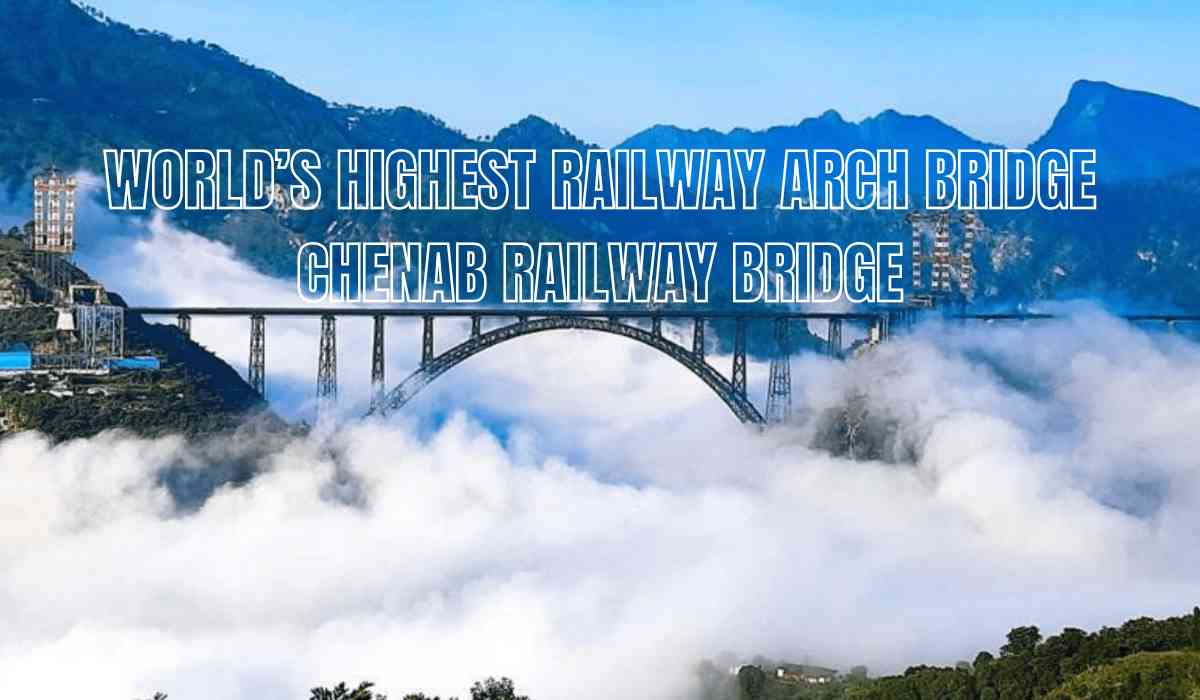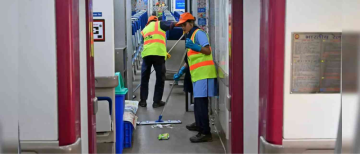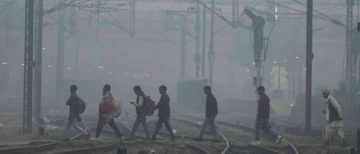On June 6, 2025, Prime Minister Narendra Modi inaugurated the Chenab Railway Bridge, the world’s highest railway arch bridge, marking a monumental milestone in India's infrastructure and Kashmir’s connectivity. This historic event, coinciding with the Eid-ul-Adha festival, symbolizes decades of perseverance and engineering brilliance to finally connect the Kashmir Valley directly with the rest of India by rail.
Alongside the bridge, PM Modi also flagged off two Vande Bharat Express trains connecting Shri Mata Vaishno Devi Katra and Srinagar, promising faster, safer, and more comfortable travel options. This inauguration heralds a transformative shift for Jammu and Kashmir, boosting strategic, economic, and social dimensions.
_1749191778.png)
Chenab Railway Bridge: Engineering Marvel and World Record Holder
-
World’s Highest Railway Arch Bridge: The Chenab Bridge towers 359 metres above the Chenab River, making it 35 metres taller than the Eiffel Tower in Paris. Spanning 1,315 metres in length, it stands as an engineering marvel globally admired.
-
Robust Construction: Built with blast-resistant steel and concrete for the first time in India, this all-weather bridge is designed to endure extreme Himalayan conditions, including wind speeds up to 266 km/h and seismic tremors in a high-risk zone.
-
Strategic Location: Situated between the remote villages of Kauri and Bakkal in Jammu and Kashmir’s Reasi district, the bridge forms a critical part of the 272-kilometre Udhampur-Srinagar-Baramulla Rail Link (USBRL).
-
Project Cost and Lifespan: Constructed at a cost of approximately ₹43,780 crore, the bridge has a projected lifespan of 120 years.
Visited the tallest railway bridge in the world, The Chenab Bridge, to review arrangements for the visit of the Hon PM @narendramodi ji tomorrow. Tomorrow is a landmark day for J&K when, finally, the valley will be connected to the rest of the country by a railway link to be… pic.twitter.com/bthZVHQ33j— Omar Abdullah (@OmarAbdullah) June 5, 2025
Udhampur-Srinagar-Baramulla Rail Link (USBRL): Connecting Kashmir to Kanyakumari
The Chenab Bridge is a pivotal segment of the USBRL project, a 272-km railway line aimed at integrating Jammu, Srinagar, and Baramulla with India’s national rail network.
Why USBRL is a Game-Changer:
-
Year-Round Connectivity: The rail link offers an all-weather alternative to the often vulnerable Srinagar-Jammu highway, which frequently shuts due to snowfall or landslides.
-
Reduced Travel Time: Train travel will cut Jammu-Srinagar commute from six hours by road to just 3 to 3.5 hours.
-
Military Mobility: The railway enhances rapid deployment of troops and supplies to sensitive border areas, crucial for national security.
-
Economic Boost: Faster movement of Kashmiri produce like apples, saffron, dry fruits, and handicrafts to major markets will invigorate the local economy.
-
Tourism Revival: Improved access and reduced travel times will rejuvenate tourism, benefiting from enhanced infrastructure and safer travel options.
-
Complex Engineering: The route includes 36 tunnels covering 119 km and 943 bridges traversing the rugged Pir Panjal and Lower Himalayan ranges.
-
Safety Features: Equipped with CCTV surveillance, fire-resistant tunnels, and blast-resistant materials, the project meets high safety standards.
-
Strategic Importance: Bridges like Chenab and Anji significantly improve connectivity in remote areas and provide critical infrastructure resilience.
-
Pilgrimage Facilitation: Enhanced rail connectivity to pilgrimage centers like Katra, the base for Vaishno Devi shrine, strengthens cultural and spiritual tourism.
-
National Integration: The USBRL reduces Kashmir’s geographical isolation by linking it seamlessly with the Indian rail network.
सपने नहीं, हकीकत बुनते हैं… pic.twitter.com/5WtFQrpAYC— Ashwini Vaishnaw (@AshwiniVaishnaw) June 6, 2025
Anji Bridge: India’s First Cable-Stayed Rail Bridge
Alongside Chenab, PM Modi inaugurated the Anji Bridge, India’s first cable-stayed railway bridge, spanning the Anji River valley.
-
Specifications: 473 metres in length, standing 331 metres tall, it is the second tallest rail bridge in India.
-
Engineering Feat: Supported by 48 cables, it surmounts difficult terrain ensuring safe and reliable passage across challenging Himalayan landscapes.
Historical Context: Decades of Vision and Effort
-
1970s: The initial idea of connecting Kashmir by rail surfaced under Prime Minister Indira Gandhi.
-
1994: Formal Cabinet approval for USBRL came during the tenure of PM P V Narasimha Rao.
-
2002: Construction work began under Atal Bihari Vajpayee’s government with funding for land acquisition.
-
Phased Commissioning:
-
Qazigund to Baramulla (118 km) in 2009
-
Banihal to Qazigund (18 km) in 2013
-
Udhampur to Katra (25 km) in 2014
-
Banihal to Sangaldan (48.1 km) in early 2024
-
-
Final Stretch Completion: The critical 46 km from Sangaldan to Reasi was completed in December 2024.
VIDEO | Jammu and Kashmir: Prime Minister Narendra Modi (@narendramodi) interacts with Udhampur-Srinagar-Baramulla rail link project team.
Union Ministers Ashwini Vaishnaw (@AshwiniVaishnaw), Dr Jitendra Singh (@DrJitendraSingh), J&K CM Omar Abdullah (@OmarAbdullah) accompanied… pic.twitter.com/1h1qP6YpVw— Press Trust of India (@PTI_News) June 6, 2025
PM Modi’s Visit: A Statement of Resilience After the Pahalgam Terror Attack
The inauguration came weeks after the tragic Pahalgam terror attack on April 22, which claimed 26 lives, marking PM Modi’s first visit to Jammu and Kashmir post-attack. His visit reinforced India’s commitment to security and development in the region.
-
Operation Sindoor: A recent counter-terror operation targeting terror infrastructure along the Line of Control.
-
Decisive Message: PM Modi emphasized national unity and the “severest punishment” for terrorists and their sponsors.
-
Symbolism: The bridge and train inaugurations symbolize peace, progress, and hope for Kashmir’s future.
VIDEO | Jammu and Kashmir: Katra-Srinagar Vande Bharat Express train all decked up ahead of being flagged off by PM Modi from Katra Railway Station.#JAmmuAndKashmir #VandeBharat
(Full video available on PTI Videos - https://t.co/n147TvrpG7) pic.twitter.com/jmbraqwqil— Press Trust of India (@PTI_News) June 6, 2025
Economic and Social Impacts
Boosting Local Economy and Trade
-
Quicker transportation of local produce including apples, cherries, saffron, and handicrafts.
-
Successful trial shipments of cherries by rail demonstrate new trade possibilities.
Reviving Tourism
-
Enhanced connectivity and comfort through Vande Bharat Express trains will attract more tourists.
-
Reduced dependence on the often-disrupted Jammu-Srinagar highway improves travel reliability.
-
New rail terminals planned across the route will ease passenger movement and goods transportation.
Technical Highlights: Tunnels and Bridges
-
The Katra-Banihal section (111 km) includes 97.4 km of tunnels — 87% of the route — and 49 bridges.
-
The T-50 tunnel, the longest railway tunnel in India, extends over 12.77 km.
-
The USBRL incorporates 25 main tunnels and 8 escape tunnels with advanced safety features.
-
The entire rail corridor traverses complex Himalayan topography, requiring cutting-edge engineering.
#WATCH | J&K: Prime Minister Narendra Modi inspects Chenab Bridge. He will inaugurate the bridge shortly.
Chenab Rail Bridge, situated at a height of 359 meters above the river, is the world's highest railway arch bridge. It is a 1,315-metre-long steel arch bridge engineered to… pic.twitter.com/IMf6tGOZH7— ANI (@ANI) June 6, 2025
The Road Ahead: Transforming Jammu and Kashmir
This infrastructure milestone will end more than 70 years of waiting for a direct rail connection between Kashmir and the rest of India. The rail link promises:
-
Enhanced strategic and military mobility.
-
Economic upliftment and job creation.
-
Social integration and cultural exchange.
-
Boost in tourism and pilgrimage circuits.
-
Safer, faster, and all-weather connectivity in a previously isolated region.
A Bridge to Peace and Prosperity
The inauguration of the Chenab Railway Bridge and the USBRL project as a whole represent more than engineering achievements—they symbolize India’s unwavering commitment to Kashmir’s development, security, and unity. As trains begin their journey over these monumental structures, they carry with them the hopes of millions for a more connected, prosperous, and peaceful future.
With inputs from agencies
Image Source: Multiple agencies
© Copyright 2025. All Rights Reserved Powered by Vygr Media.



















